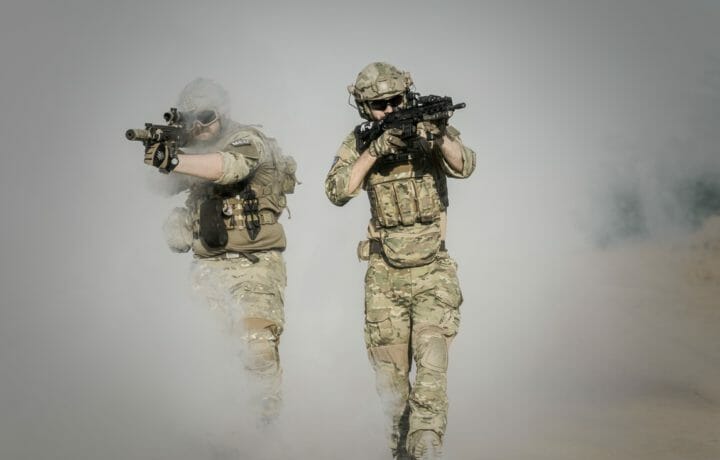If you’ve seen the protests and the federal response to them, you’ve seen what appear to be an awful lot of soldiers on American streets. Federal agents are wearing the uniform of the Army (lawfully) but in the process, muddying up the waters of who’s who.
Federal law enforcement personnel may be wearing “operational camouflage pattern” (OCP) gear because the Army has instilled a sense of professionalism and competence with that uniform, or because it’s an intimidating uniform. If you are reading this, you’re probably wondering how to identify actual soldiers who have been mobilized for security operations versus federal agents or simple civilian bystanders. This little primer on military uniforms should help.
CHECK THE UNIFORM PATTERN
First, what do military uniforms look like? This is the Army combat uniform. It uses a pattern called “operational camouflage pattern,” or OCP, which was first issued for soldiers in Afghanistan. You’ll note a couple of things on the uniform right away. “U.S. ARMY” is sewn right above the pocket, though if body armor is worn, you won’t see it. An American flag is on the right sleeve, stripes toward the rear (as if holding a flag running forward). Below that is a combat patch, issued for having served overseas with a particular military unit.
On the left sleeve is another unit patch—in this case, the unit to which the soldier is assigned. If you snap a picture of one, and the person is, in fact, a soldier, the patch is likely to appear on this page. There is a catch (of course): you’ll notice that the patches are fixed to Velcro. They can be removed (rendered a “sterile” uniform), but whether or not that is ordered is circumstantial. In Washington D.C., where the National Guard cleared protesters, they wore their unit patches, the flag of Washington, D.C., and in some cases, a U.S. Army nametape over their body armor.
There are telltale signs when it’s a soldier wearing the uniform versus a federal agent or poser.
CHECK THE BOOTS
First, check out the boots. Soldiers wear a tan (or coyote)-colored boot with a brushed suede texture. Notice that the pants of the Army combat uniform are bloused above, or into, the boots, so that you can see the laces all the way up. Other methods are highly unlikely to be considered allowable for soldiers in the U.S. Army in current circumstances. They might come un-bloused in the heat of things, but the National Guard has an image of professionalism to maintain.
OTHER PATTERNS AND WHO WEARS THEM
If you are looking at an actual member of the military in an emergency response situation, it’s almost certainly the Army. But just so you are aware: The Marine Corps wears a digital camouflage pattern called MARPAT. If you see it in the streets, you’re looking at a Marine. MARPAT is patented and not available for civilian retail purchase. If you are looking at a Marine, the situation has gone south for the U.S. government. The Marine Corps has not been used that way since 1992, during the Los Angeles riots. (If you know of another instance, please post a comment below!)
The Navy also uses a digital camouflage pattern reminiscent of MARPAT, but if you are protesting on open waters, reconsider. The Navy has attack submarines. The Air Force and Space Force also wear OCP combat uniforms, but if they’ve got the Space Force out there patrolling the streets, then Olympus has fallen and anything could happen. Stock up on canned goods immediately.
CHECK THE UNIFORM PATCHES
Some uniforms are easy to identify. If not the local or state agency, then certainly whether it’s a military branch. Dark blue uniforms with black boots and black body armor are almost certainly a police department or part of the Department of Homeland Security Federal Protective Service, the police that guard federal buildings. (Yes, the Coast Guard wears a very similar uniform, and they could certainly do the job, both legally and operationally, but it would take a very specific set of circumstances for the Coast Guard to get tied up in this, and my guess is right now everyone leading that branch is sitting very still hoping no one notices them.)
The Department of Homeland Security’s uniforms have some similarities to the U.S. Army’s uniform. Border Patrol’s Tactical Unit (BORTAC), Immigration and Customs Enforcement, and U.S. Marshals all sport a uniform that has carries some similarities. However, they should have a distinct patch on their shoulders. On one shoulder, BORTAC has been spotted generally wearing a round patch with “Border Patrol” printed on it, and a tab above that says “BORTAC.” On the other shoulder is the Department of Homeland Security shield. ICE wears a big square patch that says ICE on it, with the agency crest. The Marshals service wears a patch that says “U.S. Marshals” and its famed round police star badge.
LOCAL POLICE IDENTIFIERS
Complicating things further: local law enforcement also often wears the same uniform. Check for patches that read “SRT” (Special Response Team, usually) or “SWAT” (Special Weapons and Tactics). These are oftentimes on the upper part of the shoulder where soldiers would wear the American flag. The military-to-police equipment pipeline goes way, way back, with its roots in World War II (and then discontinued). It was reborn in the 1990s to help police fight the war on drugs. Since then, $7.5 billion in military hardware has found its way to your local PD.
The secretary of Homeland Security has said that federal agents will begin transitioning out of the Army’s uniforms. The timeline for that remains hazy.
In the meantime, whether you’re watching a local protest unfold or viewing a photo posted on your favorite social media site, it’s worth knowing whether the individual you are looking at is in fact a law enforcement or military member, or if they’ve just been carousing their local Goodwill. There should be a discernible difference. Hopefully this guide helps.



